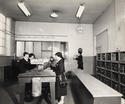 Women's lives were marked by many changes – in education and opportunities, health, dress, leisure and personal freedom – but family roles changed more slowly. Motherhood was seen as women's primary role, although war deaths and male emigration made that less likely for some. Men and women lived quite segregated lives and the sexual double-standard
surrounding notions of masculine prowess and feminine purity was strong.
Women's lives were marked by many changes – in education and opportunities, health, dress, leisure and personal freedom – but family roles changed more slowly. Motherhood was seen as women's primary role, although war deaths and male emigration made that less likely for some. Men and women lived quite segregated lives and the sexual double-standard
surrounding notions of masculine prowess and feminine purity was strong.
 Sometimes change was rapid with the mobilisation of women to work in industry and the services in both world wars. Only "clippies" (tram and bus conductresses) and women welders gained equal pay; on average women's pay was only half men's. More women were full-time housewives, but many also worked in casual jobs and "sweated work" was common. Better housing, electricity and smaller families meant domestic work became easier, although in large, poor families it was still wearyingly heavy. Contraception was hard to get until 1937 and most women had limited access to health care.
Sometimes change was rapid with the mobilisation of women to work in industry and the services in both world wars. Only "clippies" (tram and bus conductresses) and women welders gained equal pay; on average women's pay was only half men's. More women were full-time housewives, but many also worked in casual jobs and "sweated work" was common. Better housing, electricity and smaller families meant domestic work became easier, although in large, poor families it was still wearyingly heavy. Contraception was hard to get until 1937 and most women had limited access to health care.
 Young, single women found opportunities in offices and shops. Domestic service was a large, but increasingly unpopular, area of employment. New areas of work opened up in medicine, health visiting, social work and secondary teaching. In 1922 women's organisations tried unsuccessfully to prevent Glasgow Corporation dismissing married women.
Young, single women found opportunities in offices and shops. Domestic service was a large, but increasingly unpopular, area of employment. New areas of work opened up in medicine, health visiting, social work and secondary teaching. In 1922 women's organisations tried unsuccessfully to prevent Glasgow Corporation dismissing married women.
 Magazines and novels targeted the female consumer. Lipstick and powder were affordable and acceptable. There were cycling clubs, tea-rooms, the cinema and the dancing at the Barrowland.
Magazines and novels targeted the female consumer. Lipstick and powder were affordable and acceptable. There were cycling clubs, tea-rooms, the cinema and the dancing at the Barrowland.
 In the 1915 rent strike women's tenants' committees prevented evictions. Scottish Women's Co-operative Guild membership offered a night out and it campaigned on women's issues. Women such as Mary Barbour (1875-1958) and Agnes Dollan (1887-1966) moved into local and labour movement politics. In 1937 Agnes Hardie (1874-1951) became the city's first woman MP.
In the 1915 rent strike women's tenants' committees prevented evictions. Scottish Women's Co-operative Guild membership offered a night out and it campaigned on women's issues. Women such as Mary Barbour (1875-1958) and Agnes Dollan (1887-1966) moved into local and labour movement politics. In 1937 Agnes Hardie (1874-1951) became the city's first woman MP.
 One of the first strikes for equal pay was at the Rolls Royce aero-engine plant at Hillington during the Second World War. After the war, many women lost their jobs, but despite social pressures and the rising birth rate, women's employment rose during the 1950s. The NHS and family allowances had a big impact. Women worked in a wider range of occupations, more girls stayed on at school and women's aspirations and awareness of inequality grew.
One of the first strikes for equal pay was at the Rolls Royce aero-engine plant at Hillington during the Second World War. After the war, many women lost their jobs, but despite social pressures and the rising birth rate, women's employment rose during the 1950s. The NHS and family allowances had a big impact. Women worked in a wider range of occupations, more girls stayed on at school and women's aspirations and awareness of inequality grew.